Over a year ago, Marc Johnson, PhD, of the University of Missouri, developed a probe to detect H5 avian influenza A virus (IAV) genetic material in city wastewater because he expected it to start popping up in routine surveillance—just not from cattle.
"This cattle thing, that snuck up on us," he told CIDRAP News. "If this [probe] had been implemented nationally, we would've known about this in wastewater back in February, and they would have maybe gotten a lid on it sooner. It's really surprising that it became so widespread without anybody knowing."
But the probe wasn't operationalized at that time because H5N1 wasn't recognized until some cattle started showing symptoms in late March.
A low-cost, real-time option
Wastewater surveillance begins at municipal wastewater treatment plants, which serve the vast majority of cities with populations above 10,000, Johnson said. In Missouri, for example, wastewater treatment plants serve roughly 60% of the population.
Treatment plant operators collect composite samples from the water every 15 to 30 minutes and send them to a lab, where they are concentrated and the viral RNA or DNA extracted for testing. The low-cost tests tell how much virus or viral fragments are present and identify the strains.
Influenza A virus, which infects both animals and people, has been responsible for all global flu epidemics. The highly pathogenic avian influenza (HPAI) strain of H5N1 emerged in the late 1990s, it began spreading widely in wild birds and poultry and also infected people.
Particularly important for potentially zoonotic diseases

In late March, the 2.3.4.4b H5N1 clade was discovered in cows with flulike symptoms. It had already been detected in wild birds, poultry, and some wild mammals in widespread outbreaks in the United States and other countries starting in 2022. In April, the US Department of Agriculture (USDA) Animal and Plant Health Inspection Service (APHIS) released 239 genetic sequences involved in the cow outbreaks.
Since then, viral H5N1 RNA (not infectious virus) has been detected in one in five US pasteurized milk samples (but not sour cream, cottage cheese, or ground beef) in supermarkets. One case of human infection (the second documented US case) was reported in a man who worked on a dairy farm. The man developed conjunctivitis but experienced no other symptoms and has since recovered. The previous human case involved a poultry worker in Colorado in April 2022.
Last month, Emory University researchers used a hydrolysis probe-based reverse transcription-polymerase chain reaction (RT-PCR) to measure H5 concentrations in wastewater dating back to February 4 at three sentinel Texas treatment plants near the H5N1 2.3.4.4b outbreak epicenter.
The plants (two in Amarillo and one in Dallas) were chosen from 15 facilities that showed a secondary onset of IAV in March and April, after the typical flu season. Industrial discharges containing animal waste, including milk byproducts, had been released into wastewater at the Amarillo facilities.
"If dairy industry activities in these sewersheds are a primary source of H5 in wastewater, this suggests that there are [sic] may be additional, unidentified outbreaks among cattle with milk sent to these facilities since milk from infected animals is required to be diverted from food supply," the study authors wrote.
H5 wasn't detectable before mid-March but then quickly reached similar concentrations as IAV M genes—an indicator of influenza virus transmissibility—which were among the highest ever recorded in wastewater. At the same time, flu-related emergency department visits in the associated Texas public health regions were declining.
"These results suggest that wastewater monitoring is a viable method of monitoring certain animal pathogens, and can provide a leading edge of detection that is of particular importance for diseases with zoonotic potential like HPAI," the study authors wrote.
Michael Osterholm, PhD, MPH, director of the University of Minnesota's Center for Infectious Disease Research and Policy (CIDRAP), publisher of CIDRAP News, said testing wastewater systems that have no intake of animal-related sewage could serve as sentinels for human disease.
"There are those systems that have no animal input, so if they showed a spike, it could show evidence of human transmission," he said. He added that some systems like this may be testing for this now but that he hasn't seen the data yet.
Tracking mutations over time
Richard Webby, PhD, director of the World Health Organization Collaborating Centre for Studies on the Ecology of Influenza in Animals and Birds and a researcher at St. Jude Children's Research Hospital, in Memphis, Tennessee, said surveillance of both wastewater and supermarket milk samples is valuable. "It gives us a bit of a handle on whether the virus is changing as well without having to go into the contaminated environment of the farm," he said.
Surveillance at wastewater treatment plants serving meat-processing plants could also be useful, Johnson said. "We've seen this before, where we'll see viruses from animals being slaughtered showing up in the municipal wastewater," he said, adding that it could look for spillover to pigs or other animals. "The nice thing about that—it's kind of gross—but it doesn't matter which compartment the virus is in, it will end up in the wastewater."
Most respiratory viruses, such as SARS-CoV-2, which causes COVID-19, unlike enteric (intestinal) viruses, aren't infectious once they traverse the gastrointestinal tract because they are sensitive to changes in the level of acidity, Johnson said, adding that he has been unable to culture infective SARS-CoV-2 viruses from wastewater (see sidebar below).
It seems that the same is true for H5N1, which is also a respiratory virus.



















